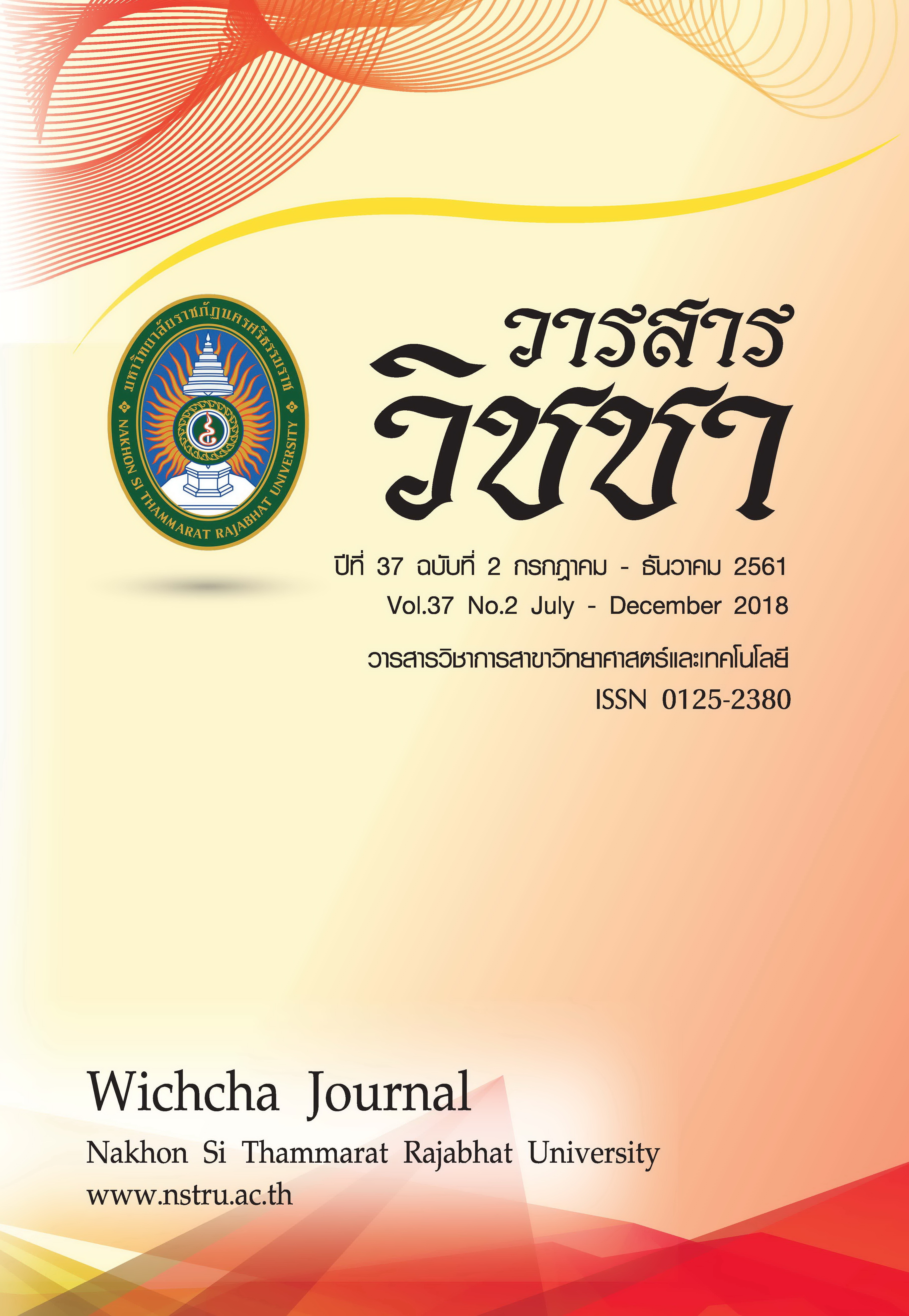Evaluation of Streptomyces spp. for Pathogenic Fungal Inhibition of Rice
Main Article Content
บทคัดย่อ
ข้าวมักประสบปัญหาในเรื่องโรคและแมลง โดยเฉพาะโรคที่เกิดจากเชื้อ อย่างเช่น โรคเมล็ดด่าง ที่มีสาเหตุจากเชื้อ Curvularia lunata Cercospora oryzae และ Fusarium semitectum และโรคใบจุดสีน้ำตาล ที่มีสาเหตุจากเชื้อ Bipolaris oryzae การป้องกันกำจัดโรคพืชเกษตรกรไทยส่วนใหญ่นิยมใช้สารเคมี แต่การควบคุมโรคพืชด้วยสารเคมีมักมีผลเสีย เพราะต้องใช้เป็นประจำและต่อเนื่อง ส่งผลทำให้เชื้อดื้อยาเกิดการปนเปื้อนสารเคมีกับผลิตผลการเกษตรและสิ่งแวดล้อม ดังนั้นการทดลองในครั้งนี้จึงมีวัตถุประสงค์เพื่อทดสอบประสิทธิภาพของเชื้อ Streptomyces spp. ที่มีประสิทธิภาพในการยับยั้งการเจริญของเชื้อ Pyricularia oryzae สาเหตุโรคใบไหม้ในข้าว จำนวน 7 ไอโซเลต ได้แก่ ไอโซเลต 2USVRA408 2USVRA105 2USVRB204 2USVRA202 2USVRA108 2USVRA104 และ 2USVRA101 มาทดสอบความสามารถในการยับยั้งเชื้อราสาเหตุโรคเมล็ดด่างของข้าว ทั้ง 3 ชนิด ได้แก่เชื้อ C. lunata C. oryzae และ F. semitectum และโรคใบจุดสีน้ำตาลในข้าว ที่มีสาเหตุจากเชื้อ B. oryzae สาเหตุ พบว่าสามารถยับยั้งเชื้อราสาเหตุโรคเมล็ดด่าง ทั้ง 3 ชนิด โดยสามารถยับยั้งเชื้อ C. lunata ได้ร้อยละ 43.56-55.44 สามารถยับยั้ง C. oryzae ได้ร้อยละ 46.56-56.78 และสามารถยับยั้งเชื้อ F. semitectum ได้ร้อยละ 52.22-65.56 ในขณะที่สามารถยับยั้งเชื้อ B. oryzae สาเหตุโรคใบจุดสีน้ำตาลในข้าว ได้ร้อยละ 50.11-56.33 โดยพบว่าเชื้อ Streptomyces spp. มีระดับการเกิดกิจกรรมของจุลินทรีย์ต่อต้านในระดับต่ำถึงปานกลาง ยกเว้นเชื้อ Streptomyces sp. ไอโซเลต 2USVRA108 มีระดับเกิดกิจกรรมของจุลินทรีย์ต่อต้านเชื้อ F. semitectum ในระดับสูง
Article Details
เนื้อหาและข้อมูลในบทความที่ลงตีพิมพ์ในวารสารวิชชา มหาวิทยาลัยราชภัฏนครศรีธรรมราช ถือเป็นข้อคิดเห็นและความรับผิดชอบของผู้เขียนบทความโดยตรง ซึ่งกองบรรณาธิการวารสารไม่จำเป็นต้องเห็นด้วยหรือร่วมรับผิดชอบใด ๆ
บทความ ข้อมูล เนื้อหา รูปภาพ ฯลฯ ที่ได้รับการตีพิมพ์ในวารสารวิชชา มหาวิทยาลัยราชภัฏนครศรีธรรมราช ถือเป็นลิขสิทธ์ของวารสารวิชชา มหาวิทยาลัยราชภัฏนครศรีธรรมราช หากบุคคลหรือหน่วยงานใดต้องการนำข้อมูลทั้งหมดหรือส่วนหนึ่งส่วนใดไปเผยแพร่ต่อหรือเพื่อการกระทำการใด ๆ จะต้องได้รับอนุญาตเป็นลายลักษณ์อักษรจากวารสารวิชชา มหาวิทยาลัยราชภัฏนครศรีธรรมราชก่อนเท่านั้น
The content and information in the article published in Wichcha journal Nakhon Si Thammarat Rajabhat University, It is the opinion and responsibility of the author of the article. The editorial journals do not need to agree. Or share any responsibility.
เอกสารอ้างอิง
ชีววิธี. วารสารโรคพืช, 9(1), 28-33.
เจนจิรา เดชรักษา และสลิลา สุรวัฒนกิจ. (2561). การแยกแอคติโนมัยสีทที่สามารถยับยั้ง Curvularia lunata สาเหตุของโรคเมล็ดด่างในข้าว. วารสารวิทยาศาสตร์เกษตร, 49(2 พิเศษ), 201-204.
ปวีณา สังข์แก้ว. (2556). สูตรสำเร็จของจุลินทรีย์ปฏิปักษ์ Streptomyces griseus subsp. formicus สำหรับการยับยั้งโรครากขาวของยางพารา. วิทยาศาสตรมหาบัณฑิต. มหาวิทยาลัยสงขลานครินทร์, สงขลา.
สมาคมผู้ส่งออกข้าวไทย. (2560). สรุปสถานการณ์ส่งออกข้าวไทยในช่วง 5 เดือนแรก และคาดการณ์แนวโน้มครึ่งปีหลัง ปี 2560. สืบค้นเมื่อ 8 มิถุนายน 2561, จาก: https://www. thairiceexporters.or.th.
สำนักงานเศรษฐกิจการเกษตร. (2559). สถานการณ์สินค้าเกษตรที่สำคัญและแนวโน้ม ปี 2560. สืบค้นเมื่อ 8 มิถุนายน 2561, จาก: https://www.oae.go.th/download/journal/trends 2559. pdf.
สำนักงานเศรษฐกิจการเกษตร. (2561). ปริมาณและมูลค่าการนำเข้าวัตถุอันตรายทางการเกษตร ปี 2554 -2560. สืบค้นเมื่อ 8 มิถุนายน 2561, จาก: https://www.oae.go.th/oae_report/
stat_agri/report_result_content.php.
Boukaew, S. and Prasertsan, P. (2014). Suppression of rice sheath blight disease using a heat stable culture filtrate from Streptomyces philanthi RM-1-138. Crop Protection, 61, 1-10.
Law, J.W.F., Ser, H.L., Khan, T.M., Chuah, L.H., Pusparajah, P., Chan, K.G., Goh, B.H. and Lee, L.H. (2017). The potential of Streptomyces as biocontrol agents the rice blast fungus, Magnaporthe oryzae (Pyricularia oryzae). Frontiers in Microbiology. 8(3), 1-10.
Prapagdee, B., Kuekulvong, C. and Mongkolsuk, S. (2008). Antifungal potential of extracellular metabolites produced by Streptomyces hygroscopicus against phytopathogenic fungi. International Journal of Biological Sciences, 4(5), 330-337.
Tokala, K.R., Strap, L.J., Jung, M.C., Crawford, L.D., Salove, H.M., Deobald, A.L., Bailey, F.J. and Morra, J.M. (2002). Novel plant-microbe rhizosphere interaction involving Streptomyces lydicus WYEC108 and the pea plant (Pisum sativum). Applied and Environmental Microbiology, 68, 2161-2171.


